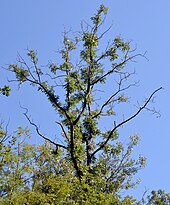Wrong white stem cup
| Wrong white stem cup | ||||||||||||
|---|---|---|---|---|---|---|---|---|---|---|---|---|

Fruit bodies of Hymenoscyphus fraxineus |
||||||||||||
| Systematics | ||||||||||||
|
||||||||||||
| Scientific name | ||||||||||||
| Hymenoscyphus fraxineus | ||||||||||||
| ( T. Kowalski ) Baral , Queloz , Hosoya |
The False White Stem Beaker ( Hymenoscyphus fraxineus ) (before the spelling reform : False White Stem Beaker ) is a species of mushroom from the subdivision of the real ashlar that was described in 2010 . Investigations on herbarium material show, however, that Hymenoscyphus fraxineus occurred in Central Europe as early as 1978. Hymenoscyphus fraxineus lives on the leaf spindles of shed ash leaves. Its secondary fruit form Chalara fraxinea triggers the death of ash shoots on the common ash and narrow-leaved ash out.
The fruiting bodies of the false white stem cup are white cup-shaped apothecia with a size of 2 to 7 mm. The spores, ascospores formed in the asci , are sticky and should be larger (15–22 µm) than in the related species Hymenoscyphus albidus with a spore length of 8–20 µm. They are supposed to be spread over the air.
Minor fruit form Chalara fraxinea
During the search for the causative agent of ash dieback in Poland in 2006, the Chalara fraxinea fungus was discovered as a byproduct of an unknown fungus. Since 2008 it has been mistaken for the secondary crop form of the white stem cup ( Hymenoscyphus albidus ). This hose fungus has been known since 1851, but has never appeared as a harmful parasite. It has been known since 2010 that Hymenoscyphus pseudoalbidus is the main fruit form of C. fraxinea .
Chalara fraxinea lives parasitically in the tissues of the leaves, shoots and lignified parts of ash trees and, according to some researchers, is involved in the increased death of these trees in Europe. So far nothing is known about the distribution strategy of Chalara fraxinea .
Chalara fraxinea attacks both young and old trees. There are suspicions that the fungus was able to prevail in Central Europe due to the increased average temperatures. Its spread probably began in the Baltic States. It is now proven in Scandinavia , Great Britain , Poland , the Czech Republic , Slovenia , Germany , Austria and Switzerland . The symptoms of the infestation are thinning crowns and withering leaves and twigs. As the fungus the pathways attacks, the tree from the top dies ago. Yellowish or reddish brown necroses form on the bark .
The ash shoot death due to the infestation with Chalara fraxinea is of the type initially a disease of the leaves and green shoots, later also of the woody parts, whereby of the inner tissues not primarily the vessels, but v. a. the parenchyma of the rays and the medulla are colonized. The conspicuous bark necrosis, which are sometimes reminiscent of a bark burn, are more of a secondary damage caused by the death of living bark and the cambium. The disease is also known as "ash dieback" or "ash wilt".
features
In culture, the fungus forms a moderately growing air mycelium that is initially white, but later turns reddish-brown to grayish or black. The vegetative hyphae are translucent to olive-brown with only a few thickenings. Thickened, pigmented cells appear in older cultures. The phialides stand solitary on the vegetative hyphae and are 20 to 40 µm long.
Individual evidence
- ^ Hans-Otto Baral, Valentin Queloz, Tsuyoshi Hosoya: Hymenoscyphus fraxineus, the correct scientific name for the fungus causing ash dieback in Europe . In: IMA Fungus . tape 5 , no. 1 , June 1, 2014, ISSN 2210-6340 , p. 79–80 , doi : 10.5598 / imafungus.2014.05.01.09 , PMID 25083409 , PMC 4107900 (free full text).
- ↑ a b c Valentin Queloz, Christoph R. Grünig, Reinhard Berndt, Tadeusz Kowalski, Thomas N. Sieber, Ottmar Holdenrieder: Cryptic speciation in Hymenoscyphus albidus . In: Forest Pathology . tape 41 , 2011, p. 133-142 , doi : 10.1111 / j.1439-0329.2010.00645.x .
- ↑ The ash dieback. In: Bavarian State Institute for Forests and Forestry (LWF) . Retrieved January 27, 2015 .
- ↑ Gregor Witzel, Berthold Metzler: Ash shoot die in poles and trees. (No longer available online.) In: waldwissen.net . December 8, 2014, archived from the original on January 28, 2015 ; accessed on January 27, 2015 . Info: The archive link was inserted automatically and has not yet been checked. Please check the original and archive link according to the instructions and then remove this notice.
- ↑ Thomas Cech, Ute Hoyer-Tomiczek: Current situation of the dying back of the ash in Austria . In: Forstschutz Aktuell . tape 40 , 2007, p. 8–10 ( PDF; 134 kB ).
- ↑ a b Volker Mrasek : Fungal parasite: ash dieback alarms forest experts. November 6, 2008, accessed January 27, 2015 .
- ↑ Roland Engesser: ash withered. In: Federal Research Institute for Forests, Snow and Landscape (WSL). Forest protection Switzerland . September 25, 2014, accessed January 27, 2015 .
- ↑ Jörg Schumacher, Alfred Wulf, Sindy Leonhard: First evidence of Chalara fraxinea T. KOWALSKI sp. nov. in Germany - a cause of novel damage to ash trees . In: News sheet of the German Plant Protection Service . tape 59 , no. 6 , 2007, p. 121–123 ( (PDF; 148 kB) ).
Web links
- Ash dieback ( BT-Drs. 19/3196 )
- FAQ - Frequently asked questions about ash dieback (www.waldwissen.net)
- What to do when the ash trees die Recommendations for action against ash dieback (www.waldwissen.net)
- Information from the Bavarian State Institute for Agriculture and Forestry
- Information from the forest protection and dendrology research group at ETH Zurich
- Symptoms of Chalara fraxinea on ash trees in the picture on forestryimages.org
- Information collection on ash wilt from the Swiss WSL
- Fungal attack on ash trees: what's next? on April 24, 2017 on ndr.de

